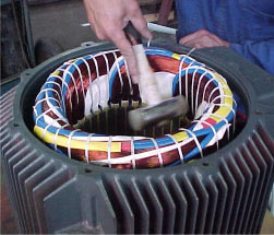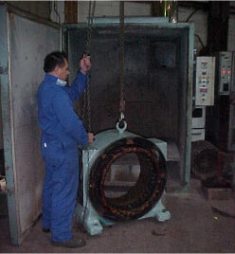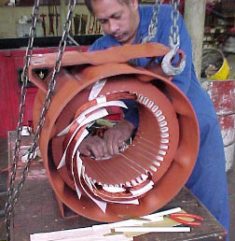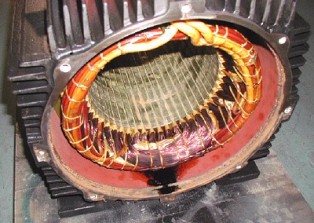Wires and insulation in electric motors
Designation of insulation of winding wires - prevention of short-circuit interruptions. In low-voltage induction motors, the turn-to-turn voltage is usually a few volts. However, short voltage pulses occur when switching on and off, so the insulation must have a large reserve of dielectric strength. Damping at one point can cause electrical damage and damage to the entire coil. Winding insulation breakdown voltage. wires should be several hundred volts.
Winding wires are usually made of fiber, enamel and enamel insulation.
 Fibrous materials based on cellulose have significant porosity and high hygroscopicity. In order to increase the electrical strength and resistance to moisture, the fiber insulation is impregnated with a special varnish. However, impregnation does not prevent moisture, it only reduces the rate of moisture absorption. Due to these disadvantages, wires with fiber and enamel insulation are currently almost not used for winding electrical machines.
Fibrous materials based on cellulose have significant porosity and high hygroscopicity. In order to increase the electrical strength and resistance to moisture, the fiber insulation is impregnated with a special varnish. However, impregnation does not prevent moisture, it only reduces the rate of moisture absorption. Due to these disadvantages, wires with fiber and enamel insulation are currently almost not used for winding electrical machines.
Wires used for the manufacture of windings of electric motors
The main types of wires with enamel insulation used for the manufacture of windings of various electric motors and electrical appliances, — polyvinyl acetal PEV wires and PETV wires with increased heat resistance on polyester varnishes... The advantage of these wires lies in the small thickness of their insulation, which makes it possible to increase the filling of the channels of the electric motor. PETV wires are mainly used for the windings of asynchronous motors with a power of up to 100 kW.
Live parts must also be isolated from other metal parts of the electric motor. First of all, you need reliable insulation of wires laid in the stator and rotor channels. For this purpose, use varnished fabrics and fiberglass, which are fabrics based on cotton, silk, nylon and glass fibers impregnated with varnish. Impregnation increases the mechanical strength and improves the insulating properties of varnished fabrics.
During operation, the insulation is exposed to various factors that affect its characteristics. Basic heating, humidification, mechanical forces and reactive substances in the environment must be considered... Let's look at the influence of each of these factors.
How heating affects the insulation properties of electric motors
The flow of current through the wire is accompanied by the release of heat, which heats up the electrical machine. Other sources of heat are losses in the stator and rotor steel caused by the action of an alternating magnetic field, as well as mechanical losses due to friction in the bearings.
In general, about 10 - 15% of all electrical energy consumed by the network is somehow converted into heat, creating a temperature rise of the motor windings above the ambient. As the load on the motor shaft increases, the current in the windings increases. It is known that the amount of heat generated in the wires is proportional to the square of the current, therefore overloading the motor leads to an increase in the temperature of the windings. How does this affect isolation?
Overheating changes the structure of the insulation and drastically deteriorates its properties... This process is called aging... The insulation becomes brittle and its dielectric strength drops sharply. Microcracks appear on the surface, into which moisture and dirt penetrate. In the future, damage and burning of part of the windings occurs. As the temperature of the windings increases, the life of the insulation is reduced drastically.
Classification of electrical insulating materials according to heat resistance
Electrical insulating materials used in electrical machines and apparatus, according to their heat resistance, are divided into seven classes. Of these, five are used in asynchronous electric motors with a cage of up to 100 kW.
Non-impregnated cellulose, silk and cotton fibrous materials belong to class Y (permissible temperature 90 ° C), impregnated cellulose, silk and cotton fibrous materials with wire insulation based on oil and polyamide varnishes — up to class A (permissible temperature 105 ° C), synthetic organic films with wire insulation based on polyvinyl acetate, epoxy, polyester resins - up to class E (allowable temperature 120 ° C), materials based on mica, asbestos and fiberglass used with organic binders and impregnating compounds, enamels with increased heat resistance — up to class B (permissible temperature 130 ° C), materials based on mica, asbestos and fiberglass used in combination with inorganic binders and impregnating compounds, as well as other materials corresponding to this class — up to class F (permissible temperature 155 ° C).
Electric motors are designed so that at rated power the temperature of the windings does not exceed the permissible value... Usually there is a small reserve of heating. Therefore, the rated current corresponds to heating slightly below the limit. In the calculations, the ambient temperature is assumed to be 40 ° C... If the electric motor is operated under conditions where the temperature is always known to be below 40 ° C, it may be overloaded. The overload value can be calculated taking into account the ambient temperature and the thermal properties of the motor. This can only be done if the engine load is strictly controlled and you can be sure that it does not exceed the calculated value.
How moisture affects the insulation properties of electric motors
Another factor that significantly affects the life of insulation is the effect of moisture. At high air humidity, a wet film forms on the surface of the insulating material. In this case, the surface resistance of the insulation drops sharply. Local pollution contributes to the formation of a water film. Through cracks and pores, moisture penetrates the insulation, reducing it electrical resistance.
Fiber insulated conductors are generally not moisture resistant. Their moisture resistance is increased by impregnation with varnishes. Enamel and enamel insulation is more resistant to moisture.
it should be noted that the rate of moistening depends significantly on the ambient temperature... At the same relative humidity, but at a higher temperature, the insulation moistens several times faster.
How mechanical forces affect the insulation properties of electric motors
Mechanical forces in the windings arise from various thermal expansions of individual parts of the machine, vibration of the casing and when the engine is started. Usually magnetic circuit heats up less than copper coils, their coefficients of expansion are different. As a result, copper at operating current elongates by a tenth of a millimeter more than steel. This creates mechanical forces inside the groove of the machine and movement of the wires, which causes wear of the insulation and the formation of additional gaps into which moisture and dust penetrate.
Starting currents, 6 — 7 times higher than nominal, create electrodynamic effortsproportional to the square of the current. These forces act on the coil, causing deformation and displacement of its individual parts.Casing vibration also causes mechanical forces that reduce the strength of the insulation.
Bench tests of motors have shown that with increased vibration accelerations, the winding insulation defect can increase 2.5 — 3 times. Vibration can also cause accelerated bearing wear. Motor oscillations can occur due to shaft misalignment, uneven loading, uneven stator-to-rotor air gap, and voltage imbalance.
Influence of dust and chemically active media on the insulation properties of electric motors
Airborne dust also contributes to deterioration of insulation. Solid dust particles destroy the surface and, settling, contaminate it, which also reduces electrical strength. The air of industrial premises contains impurities of chemically active substances (carbon dioxide, hydrogen sulphide, ammonia, etc.). In chemically aggressive environments, the insulation quickly loses its insulating properties and deteriorates. Both factors, complementing each other, significantly accelerate the process of insulation destruction. In order to increase the chemical resistance of the windings, special impregnating varnishes are used in electric motors.
The complex effect of all factors on the windings of electric motors
Motor windings are often subjected to simultaneous effects of heating, humidification, chemical components and mechanical loading. Depending on the nature of the engine load, environmental conditions and duration of operation, these factors may vary. In variable load machines, heating can be a dominant effect.In electrical installations operating in livestock buildings, the most dangerous for the motor is the effect of high humidity in combination with ammonia vapors.
One can imagine the possibility of designing such an engine to withstand all these adverse factors. However, such a motor would obviously be too expensive, as it would require reinforcement of the insulation, a significant improvement in its quality, and the creation of a large margin of safety.
They act differently. To ensure reliable operation of the engine, a system of measures is used to ensure the standard service life. First of all, due to the use of better materials, they improve the technical characteristics of the engine and its ability to withstand the action of factors that destroy the insulation. Improve engine protection equipment… Finally, they provide support for timely troubleshooting of faults that may lead to crashes in the future.




